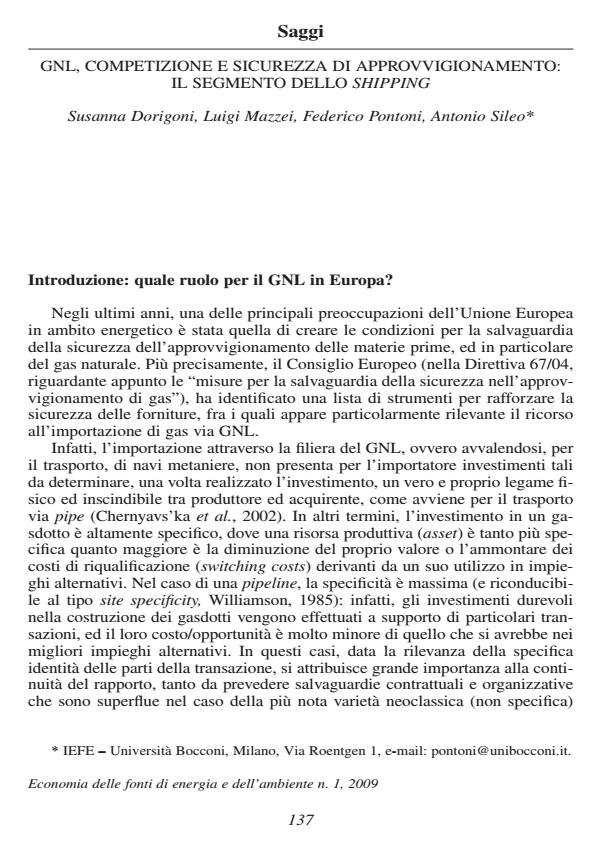GNL, competizione e sicurezza di approvvigionamento: il segmento dello shipping
Titolo Rivista ECONOMIA DELLE FONTI DI ENERGIA E DELL’AMBIENTE
Autori/Curatori Susanna Dorigoni, Luigi Mazzei, Federico Pontoni, Antonio Sileo
Anno di pubblicazione 2009 Fascicolo 2009/1 Lingua Italiano
Numero pagine 23 P. 137-159 Dimensione file 725 KB
DOI 10.3280/EFE2009-001009
Il DOI è il codice a barre della proprietà intellettuale: per saperne di più
clicca qui
Qui sotto puoi vedere in anteprima la prima pagina di questo articolo.
Se questo articolo ti interessa, lo puoi acquistare (e scaricare in formato pdf) seguendo le facili indicazioni per acquistare il download credit. Acquista Download Credits per scaricare questo Articolo in formato PDF

FrancoAngeli è membro della Publishers International Linking Association, Inc (PILA)associazione indipendente e non profit per facilitare (attraverso i servizi tecnologici implementati da CrossRef.org) l’accesso degli studiosi ai contenuti digitali nelle pubblicazioni professionali e scientifiche
LNG, Competition and Security of Supply: the Role of Shipping - In the last few years, one of the main concerns of European Union in the energetic field has been that of facilitating the safeguard of raw materials’ security of supply, especially that of natural gas. Import through LNG chain, that is, through the employment of LNG tankers for gas transportation, has been identified by the European Council as one of the instruments to achieve these goals. In fact, import via LNG does not require, for the importer, such investments as to determine an indissoluble physical tie between producer and buyer, as happens for transport via pipeline (Chernyavs’ka et al., 2002). In other words, investments in pipelines are very specific. Moreover, as they are made in order to support specific transactions, contracts usually take the form of long-term agreements with minimum offtake requirements (take or pay clauses): such contracts definitely contribute to the "cartelization" of the market, hindering competition. Unlike investments in pipelines, those in the LNG chain present a much lower degree of specificity: in fact, even though the construction of a regasification plant is generally tied to the stipulation of a long-term agreement (with take or pay clause), LNG chain costs have significantly decreased over time (until a few years ago) and, moreover, it is getting increasingly common that part of plant capacity is made available for spot transactions. What’s more, once the contract is expired and the investment is sunk, the importer may satisfy his gas supply needs on the basis of his relative gains. As far as LNG import contractual practices are concerned, significant changes have started to take places in the last few years, both in terms of agreements’ length - average duration has significantly decreased - and in terms of price indexation - in the most developed markets LNG price is tied to gas spot price (IEA, 2006). One of the many possible advantages of transport via LNG is that liquefied gas enables European importers to widen their gas suppliers portfolio. Increased possibilities of choice for importers, the widening of the group of exporting countries, and the increased integration of the European market, thanks to the possibility of redirecting cargoes depending on single countries’ supply-demand balance, would contribute decisively to security of supply, market globalization and competition (between importers) in the industry (IEA, 2004). Yet, it must be stressed that import via tanker appears to be competitive with import via pipe only for the medium-long distances. As far as LNG chain is concerned, the element that so far has attracted the least attention, though being not less important than the other two, is certainly shipping. Being the link between the producing/exporting country and the importing country, and having been subject to major changes in the last few years, it is particularly interesting to analyze it singularly, aiming to understand how it is linked to the other elements of LNG value chain, besides studying industry dynamics. This paper will address this issue, aiming also to understand what has been and what will be in the future the evolutionary trajectory of this segment, starting from an analysis of operative and planned gas tankers, their size, their routes and their contractual situation. This analysis can be useful to make hypothesis about the growth of the spot market and, consequently, of market liquidity.
Keywords: LNG, gas tankers, security of supply, competition, regasification plants, spot market, natural gas international trade
JEL classifications: L95, K12, F14, L11
Parole chiave: GNL, navi gasiere, sicurezza dell’approvvigionamento, competizione, rigassificatori, mercato spot, commercio internazionale di gas naturale;
Susanna Dorigoni, Luigi Mazzei, Federico Pontoni, Antonio Sileo, GNL, competizione e sicurezza di approvvigionamento: il segmento dello shipping in "ECONOMIA DELLE FONTI DI ENERGIA E DELL’AMBIENTE" 1/2009, pp 137-159, DOI: 10.3280/EFE2009-001009